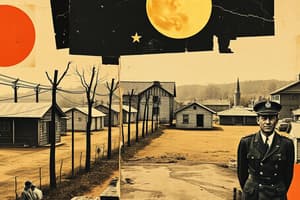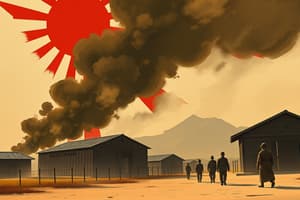Podcast
Questions and Answers
What was the purpose of Executive Order 9066?
What was the purpose of Executive Order 9066?
To exclude anyone deemed a threat to national security
Why were Japanese Americans in Hawaii not sent to incarceration camps like those on the U.S. mainland?
Why were Japanese Americans in Hawaii not sent to incarceration camps like those on the U.S. mainland?
Due to logistical and economic reasons
What did incarcerees at the internment camps in Heart Mountain have to do with their belongings?
What did incarcerees at the internment camps in Heart Mountain have to do with their belongings?
Could only take what they could carry with them
How did the education system operate in the internment camps?
How did the education system operate in the internment camps?
What activities did students at Heart Mountain engage in outside of school?
What activities did students at Heart Mountain engage in outside of school?
What was the response to rumors about food rationing at Heart Mountain?
What was the response to rumors about food rationing at Heart Mountain?
What is the main focus of the National World War II Museum in New Orleans, Louisiana?
What is the main focus of the National World War II Museum in New Orleans, Louisiana?
Who hosts an electronic field trip at the museum to educate students about Japanese American experiences during World War II?
Who hosts an electronic field trip at the museum to educate students about Japanese American experiences during World War II?
Which two students explore the stories of Japanese Americans forcibly removed from the West Coast during World War II?
Which two students explore the stories of Japanese Americans forcibly removed from the West Coast during World War II?
What gallery at the museum focuses on the tragic story of Japanese Americans uprooted from their homes and incarcerated during the war?
What gallery at the museum focuses on the tragic story of Japanese Americans uprooted from their homes and incarcerated during the war?
Who discusses Walter Imahara's family origins in Japan and California, highlighting their experiences at incarceration camps during World War II?
Who discusses Walter Imahara's family origins in Japan and California, highlighting their experiences at incarceration camps during World War II?
What event served as the catalyst for fears of a Japanese invasion, leading to President Roosevelt signing Executive Order 9066?
What event served as the catalyst for fears of a Japanese invasion, leading to President Roosevelt signing Executive Order 9066?
Flashcards are hidden until you start studying
Study Notes
- The National World War II Museum in New Orleans, Louisiana, tells the story of the American experience in World War II, including why it was fought, how it was won, and its significance today.
- Scott Fujita, a former NFL linebacker, hosts an electronic field trip at the museum to educate students about Japanese American experiences during World War II.
- Students Rio and Cavell explore the stories of Japanese Americans forcibly removed from the West Coast during World War II, with ASL interpretation and English captioning available.
- The text delves into the history of Issei immigrants in the 1880s who faced racism and worked in various industries, despite being barred from American citizenship.
- Walter Imahara's family origins in Japan and California are discussed, highlighting their experiences at incarceration camps during World War II.
- The United But Unequal gallery at the museum focuses on the tragic story of Japanese Americans uprooted from their homes on the West Coast and incarcerated during the war.
- Aaron Aoyama, a researcher at Brown University whose family was also incarcerated at Heart Mountain, answers student questions and provides expert insight on the topic.- The attack on Pearl Harbor was the catalyst for fears of a Japanese invasion, leading to President Roosevelt signing Executive Order 9066.
- Executive Order 9066 gave the military authority to exclude anyone deemed a threat to national security, resulting in the mass removal and incarceration of persons of Japanese ancestry from the West Coast.
- Families had about 10 days to prepare after evacuation orders were issued, with exclusion orders posted publicly.
- People of Japanese ancestry in Hawaii were not sent to incarceration camps like those on the U.S. mainland due to logistical and economic reasons.
- Japanese Americans in Hawaii were largely under martial law and faced suspicion and FBI roundups.
- Families on the U.S. mainland largely lost everything they left behind, returning to find new occupants in their homes or looted belongings.
- Incarcerees could only take what they could carry with them to the internment camps.
- The Heart Mountain camp in Wyoming housed over 10,000 incarcerates in barracks with communal facilities and minimal privacy.
- Families in camps like Jerome and Rohwer in Arkansas faced harsh conditions in swamp lands with barbed wire fences and guard towers.
- Education systems in the camps were established, with schools starting to operate to provide education for the incarcerates.- Barracks substituted for classrooms at Heart Mountain lacked supplies, furniture, and heating, with students sitting on benches and teachers using boxes for desks.
- Heart Mountain High School was completed on May 27, 1943, equipped with classrooms, a gymnasium, library, home economics room, machine shop, and wood shop.
- The high school also hosted dances, athletic events, published a student newspaper (Heart Mountain Eagle), and a yearbook (The Tempo).
- Outside of school, students at Heart Mountain engaged in activities like ice skating, swimming, scouting, art classes, attending movie theaters, sports events, and cultural celebrations.
- Initially, the food at Heart Mountain was described as "grim" with long lines at the mess hall, serving American food instead of traditional Japanese food.
- In response to rumors about food rationing, Heart Mountain created an agricultural department to provide incarcerates with fresh produce, growing 52 types of vegetables.
- The Roar yearbook from Warrior Center High School in 1944 depicted students trying to create normalcy in abnormal conditions, reflecting life in tar paper shacks with limited privacy.
- Families faced challenges re-entering society after leaving the internment camps, dealing with prejudice and rebuilding their lives.
- Incarcerated Japanese Americans faced different circumstances than those in the Holocaust concentration camps, with the former able to rebuild lives post-incarceration.
- Some non-Japanese Americans protested the incarceration of Japanese Americans, including individuals like a Mexican-American student named Ralph who visited internment camps as a form of protest.
Studying That Suits You
Use AI to generate personalized quizzes and flashcards to suit your learning preferences.




